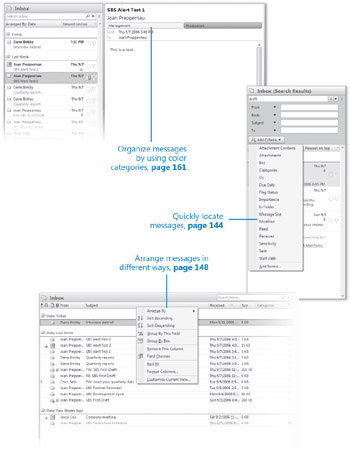Chapter 5: Managing Your Inbox
Overview
Chapter at a glance

Quickly locate messages, page 144
Arrange messages in different ways, page 148
Organize messages by using color categories, page 161
So far in this book, we've discussed the basic mechanics of sending and receiving messages, and the Outlook components used for those purposes. Now we'll tackle the task that heavy e-mail users spend a lot of time on-managing the messages you receive. This is where Microsoft Office Outlook 2007 really stands apart from its competitors.
In addition to providing ways to organize messages in subfolders within the Inbox and to archive messages, Outlook 2007 includes a number of new features that simplify the process of managing messages and other Outlook items. The greatest of these is the new Instant Search capability, which filters messages as you type the keywords you want to search for, highlighting the search terms within each message. Another useful tool is Color Categories, which combines the named categories available in earlier versions of Outlook with colored labels to provide quick visual recognition and search capabilities.
In this chapter, you will filter and find messages by using Instant Search, display the messages in your Inbox in a variety of arrangements, and use Search Folders. Then you will organize messages by assigning color categories and by organizing them in folders within the Inbox. Finally, you will look at the default archive settings and manually archive an e-mail folder.
See Also Do you need only a quick refresher on the topics in this chapter? See the Quick Reference entries on pages xxxvii–lxv.
| Important | The exercises in this chapter require only practice files created in earlier chapters; none are supplied on the book's CD. For more information about practice files, see "Using the Book's CD" on page xxv. |
| Troubleshooting | Graphics and operating system-related instructions in this book reflect the Windows Vista user interface. If your computer is running Microsoft Windows XP and you experience trouble following the instructions as written, please refer to the "Information for Readers Running Windows XP" section at the beginning of this book. |
EAN: 2147483647
Pages: 137